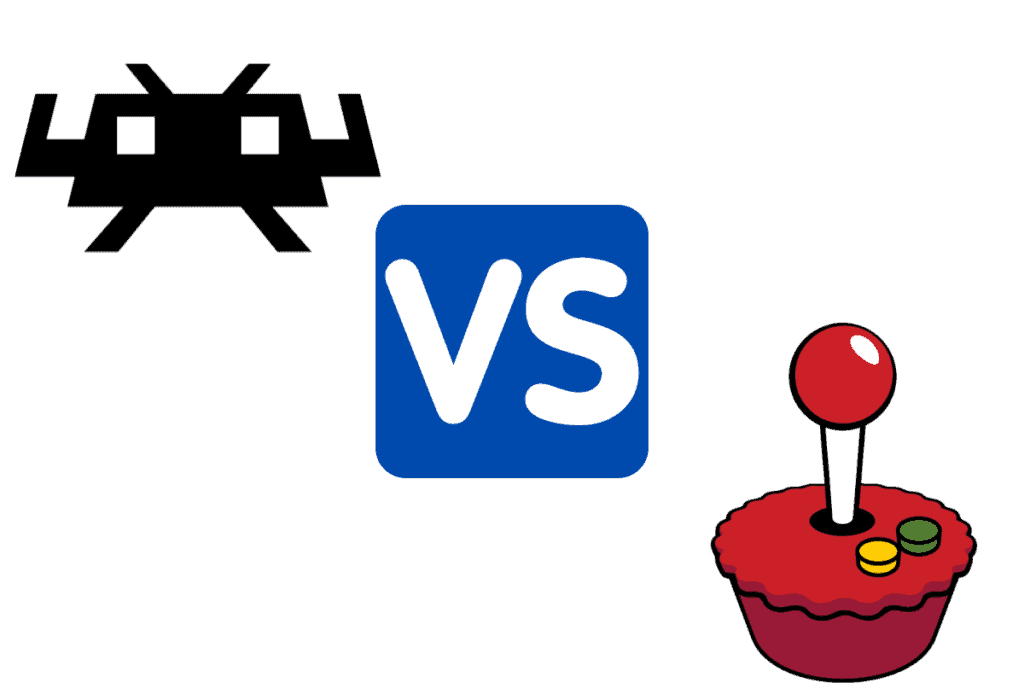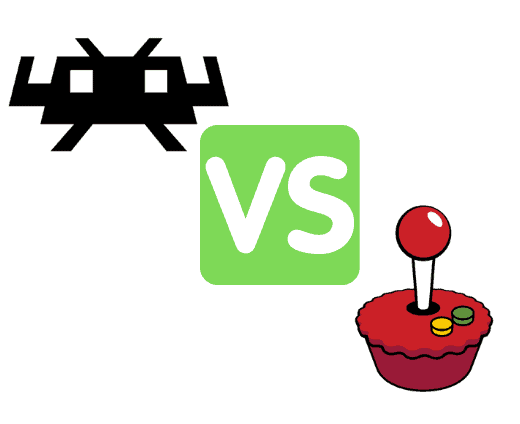As adults across the globe are forced to spend more time at home due to the pandemic, they are turning to the games that they used to ease their stress and occupy their time. While nothing beats playing a retro game on its original system, finding a physical copy of the game and system is time consuming and expensive. That is where emulators come into play.
RetroPie is a suite of software that can be installed on a Raspberry Pi allowing gamers to play thousands of retro titles. One of the pieces of software that is included in the RetroPie suite is RetroArch, a front-end for emulators, game engines and media players.
The differences between RetroPie and RetroArch are often confusing for someone who is new to the retro gaming world. In this article, we will break down the differences between RetroPie and RetroArch and identify how the software suite and piece of software function together.

Raspberry Pi: Basics to Know Before RetroPie
In order to understand how RetroArch and RetroPie differ and function it is first important to understand the computer behind the systems.
Raspberry Pi is simply a single-board computer that offers its users high-performance for a low cost.
Certain organizations offer free software, like RetroPie, for customers to be able to use the computer at a low-cost. Raspberry Pi offers students, young and old, the opportunity to learn computing and computer science through a variety of clubs and events.
While the Raspberry Pi computer has many uses, retro gamers have adapted the computer as their hardware of choice due to its versatility and low-cost.
Components of a Raspberry Pi Gaming System
The Raspberry Pi is just the computer board; therefore, it is practically useless without some additional components. At the bare minimum you will need the following things to use your Raspberry PI to start gaming:
- Raspberry Pi 4 Model B ($53/$89) – This is the computer board and only the computer board. They offer the computer with 2GB, 4GB, or 8GB of RAM. The additional money more RAM is well worth the faster processing speeds.
- Raspberry Pi Case ($25) – Since the Raspberry Pi is a computer board you will want to protect it from damage or potential spills. I personally recommend the Argon ONE V2. It offers superior heat dissipation with both active and passive cooling. Additionally, it converts the Raspberry Pi’s micro HDMI ports to full-size HDMI ports.
- Bluetooth Controller ($50) – The Raspberry Pi has Bluetooth capability and you will want a controller so that you can play games. There are several options out there, so we recommend a controller that mimics the system you anticipate emulating the most. You can map buttons for any emulator. An absolutely fantastic controller that works well for many systems is the 8BitDo Pro 2. As a nice bonus, you may not need to purchase a controller at all. Any modern Bluetooth-enabled controller will probably work just fine.
- Micro SD Card, 32GB ($11) – You will need a Micro SD card to save your operating systems and game data on. You can upgrade to a larger card if you are planning on running a lot of games from CD-based systems, but the 32GB is a good starting point.
- Raspberry Pi 4 Power Supply ($10) – The computer board does not come with a power supply, so you will need this to actually turn on the computer.
- Monitor ($80) – You can spend anywhere from $80 to $300 for a computer monitor. Make sure that you buy one that has an HDMI port as this is how you will connect your monitor to the computer board.
- Speakers ($20) – Again you can opt to spend a lot of money on a nice set of speakers, but you can get basic speakers for the system for $20.
- Micros SC Card Reader ($10) – Some laptops or computers already have this, but if your laptop does not have this, then you will need to purchase one to transfer downloaded files from your computer to your Raspberry Pi.
When all is said and done you can purchase your entire gaming set-up for about $263. The great thing about building your gaming set-up is that you can always upgrade individual components or add extra monitors as you have the money.
RetroPie: Three Projects in One

The Raspberry Pi does not come with RetroPie pre-installed. In order to use the software suite, you will need to download it from the company’s website. Once you have downloaded the suite you will need to flash it to the SD card that you will be using for your Raspberry Pi.
Which Systems Can I Play Using RetroPie?
RetroPie is essentially the next generation of emulators. It builds upon the work that was done in previous projects like Raspbian, EmulationStation, and RetroArch. In total, you can emulate 51 systems using RetroPie.
They are:
- 3do
- Amiga
- Amstrad CPC
- Apple II
- Atari 2600
- Atari 5200, 8 bit
- Atari 7800
- Atari Jaguar
- Atari Lynx
- Atari ST, STE, TT, Falcon
- Colecovision
- Color Computer
- Commodore 64
- Dragon 32
- Dreamcast
- Gameboy Advance
- GameCube
- Game Gear
- Game Boy
- Game Boy Color
- Genesis
- Intellivision
- Macintosh
- MAME
- Master System
- MSX
- Neo Geo
- Neo Geo Pocket
- Neo Geo Pocket Color
- Nintendo 64
- Nintendo DS
- Nintendo Entertainment System (NES)
- Oric
- PC
- PC Engine
- PlayStation 1
- PlayStation 2
- PSP
- SAM Coupé
- Sega 32X
- Sega CD
- Sega SG-1000
- Super Nintendo Entertainment System
- TI-99/4A
- TRS-80
- Vectrex
- Videopac
- Virtual Boy
- Wii
- Wonderswan
- Wonderswan Color
- ZX Spectrum
As you can see from the list above, RetroPie is pretty much all inclusive when it comes to retro gaming.
How Do I Get Games on My Raspberry Pi?
After you install RetroPie and launch it using your Raspberry Pi you will notice that none of the above listed emulators are on the display. This is because an emulator does not appear until a game for that emulator has been added to your Raspberry Pi.
Games for the emulators can be found online and are known as ROMs. There are four different types of ROMs:
- Copyrighted – These are ROMs that are still protected under their original content and are typically illegal to download.
- Abandonware – ROMs that technically still have a copyright, but the business that copyrighted the game is no longer operational or the company will no longer pursue legal action for using the copyrighted game.
- Public Domain – ROMs that are publicly available for personal use.
- Homebrew– ROMS that were created after a system’s “hay day” and are meant to be used on the emulators.
We don’t recommend using a copyrighted ROM; a simple Google search will bring you to a plethora of legal roms. For more information, check out my other blog post about adding ROMs to RetroPie here.
RetroArch: Multiple Emulators in One Package

Now that we have established what RetroPie is, let’s take a look at defining RetroArch. As we suggested earlier in this article, RetroArch is a front-end for emulators, game engines and media players. Basically, RetroArch is the program that allows you to use all of the “cores”, otherwise known as plug-ins, created by Libretro.
Before projects like RetroArch, retro gamers that were using emulators would have to download each individual emulator and access it on a different platform. The solution that RetroArch presented was combining all of the various emulators into one easy to access program.
Let’s take a look at some of the cool features that RetroArch offers, along with what systems you can use RetroArch on and what emulators are available.
Where Can I Use RetroArch?
The nice thing about RetroArch is that it is widely available and can be used on pretty much any operating system that you already have.
Below is a list of where RetroArch is available:
- Windows
- Mac
- Linux
- Android
- iOS
- Wii (must be hacked)
With the ease of accessibility RetroArch is available to pretty much everyone with a computer or phone.
Which Systems Can I Emulate Using RetroArch?
RetroArch works a little differently than RetroPie in that emulators are added as a core. Therefore, each system that you would like to emulate requires its own core to be installed in RetroArch. Some of the main cores available for RetroArch include:
- NES
- SNES
- Genesis
- Gameboy Advance
- Nintendo DS
- PS1
- PS2
- N64
There is also a GameCube core for RetroArch, but it is not very stable so you are better off using a separate emulator if you would like to play GameCube games.
Another important thing to consider is that each core, or emulator, has its own graphics setting. You should play around with the graphics after installing a core to see what works best for your system.
Using Shaders in RetroArch
One unique feature to RetroArch is a shader, which is essentially a graphic filter that can improve the rendering of old games. If the game is not visually appealing on your system, then you are able to use a shader to try and enhance the visual appeal of the game.
In addition, you can use shaders to try and replicate the visual effects created by the original system. For example, if you are emulating the Gameboy Advance and you recall the color and picture quality being washed out and grainy, you can adjust your shaders to emulate that effect. The shaders can go a long way in helping the nostalgia factor in playing some of your old favorite games.
Latency in RetroArch
One of the long-standing problems that emulators have is issues with latency, otherwise known as input responsiveness. When using an emulator there is typically a slight delay from the gamer pushing a button to the intended action actually occurring on the screen. This can be an issue when playing fast-paced games that require a quick response time.
RetroArch claims to have fixed this issue with a next-frame response time so that it is comparable to the feel of playing the game on its original system. If you are experiencing latency issues, they have included tools like frame delay and adjustable audio buffering to help combat the problem.
The lack of latency issues is a huge benefit in using RetroArch, as there is nothing more frustrating than getting sucked into a retro video game only to have lag issues during the most exciting or intense moments of the game.
Comparing RetroArch and RetroPie

When comparing RetroPie and RetroArch things tend to get a little confusing for gamers who are not familiar with the two systems. RetroPie uses RetroArch and builds upon it to make it better for Raspberry Pi users. Therefore, when you are using RetroPie, you are also using RetroArch.
When you install RetroPie on your Raspberry Pi you are using three major projects combined into one:
- Raspberry Pi OS (Formerly known as Raspian) – the main operating system used for Raspberry Pi.
- EmulationStation – a polished game launcher that includes controller and keyboard support, custom themes and a scraper for box art and game metadata.
- RetroArch – the front-end for a variety of emulators
While RetroPie uses the technology from RetroArch, there are some distinct differences between using RetroArch by itself and using it inside of RetroPie.
Mapping Controller Buttons
Since RetroPie uses EmulationStation you map out the buttons when first launching the software to be able to navigate to the various emulators. Since you are mapping the buttons outside of an individual emulator, you should not have to re-map the buttons when using different emulators inside of RetroPie.
This is not the case in RetroArch, where you would be required to map the buttons for your controller every time that you use a new core. This can save you time when using a new emulator, along with allowing you to not have to deal with minutiae of the mapping process several times over.
RetroPie Has Cores Pre-Installed
Another benefit of using RetroPie is that the cores are already installed when you download the system. This means that you do not have to download each individual emulator that you would like to use. As mentioned earlier, each emulator will not appear in RetroPie until you download a ROM specific to that emulator.
The downside to having the cores pre-installed in RetroPie is that they may not always be up to date. Updates to the emulators in RetroPie are typically a week or two behind them actually being released.
This can be a benefit as it gives developers an opportunity to identify potential issues with updates before actually installing them on your system, but updates will typically improve performance and address latency issues so delaying means dealing with these issues for longer.
If you are worried about having the most up-to-date software at all times, then you are better off sticking with RetroArch.
It is important to note that previous models of the Raspberry Pi did not have WIFI built in. Therefore, if you have a Raspberry Pi Model 2 or earlier, then you would need to either purchase a WIFI dongle or ethernet connector in order to update emulators directly from your Raspberry Pi. If not, you would need to go through the hassle of checking for various updates on your laptop or home computer.
RetroPie was Built for Raspberry Pi
RetroPie was built with the Raspberry Pi in mind. Therefore, if you are looking to use RetroPie it is in your best interest to purchase a Raspberry Pi and all the equipment associated with building your gaming set-up.
RetroPie can be run on a ODroid C1/C2 or PC, but since RetroPie uses its own operating system you would need to use a device that you don’t plan on using for anything else in order to run RetroPie.
RetroArch works on a wide-variety of operating systems and does not use its own operating system. Therefore, if you do not want to invest in a Raspberry Pi using RetroArch would allow you to game on a device or system that you already have. This is a good option if you are looking to test out RetroArch before spending the time and money on an entirely new set-up.
Why Not Just Use an Individual Emulator?
RetroArch and RetroPie both solve the problem of not having to download and use multiple different emulators. You might be wondering if there is an instance where it is just better to use an individual emulator, then either RetroPie or RetroArch.
If you only want to emulate one system, then just downloading an individual emulator might be a better option for you. However, if you would like to play games across multiple different platforms, then the convenience of RetroArch and RetroPie cannot be beat.
There is a caveat in that RetroArch and RetroPie both are designed so that emulators function at optimal performance when being run using their software. Therefore, if you are having trouble finding a high-quality individual emulator, then you might try the RetroArch or RetroPie version of that emulator to see if it performs better than the individual emulator.
In addition, RetroArch and RetroPie both come with cool features like shading and a lack of latency issues that aren’t typically included in stand alone emulators.
Final Thoughts
In conclusion, if you are using Raspberry PI, then RetroPie is the way to go, but if you are using a different device for more than just gaming you should go with RetroArch. Since both pieces of software use the same technology you can’t go wrong with either one. The most important part is to find the software that works for you so that you can focus on enjoying the game.
Sources:
